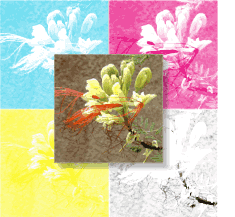Screen printing is also a stencil method of print making in which a design is imposed on a screen of silk or other fine mesh, with blank areas coated with an impermeable substance, and ink is forced through the mesh onto the printing surface. It is also known as Screen Printing, silkscreen, seriography, and serigraph.
The screen is placed atop a substrate such as paper or fabric. Ink is placed on top of the screen, and a fill bar (also known as a floodbar) is used to fill the mesh openings with ink. The operator begins with the fill bar at the rear of the screen and behind a reservoir of ink. The operator lifts the screen to prevent contact with the substrate and then using a slight amount of downward force pulls the fill bar to the front of the screen. This effectively fills the mesh openings with ink and moves the ink reservoir to the front of the screen. The operator then uses a squeegee (rubber blade) to move the mesh down to the substrate and pushes the squeegee to the rear of the screen. The ink that is in the mesh opening is pumped or squeezed by capillary action to the substrate in a controlled and prescribed amount, i.e. the wet ink deposit is proportional to the thickness of the mesh and or stencil. As the squeegee moves toward the rear of the screen the tension of the mesh pulls the mesh up away from the substrate (called snap-off) leaving the ink upon the substrate surface.


Screenprinting materials:
Plastisol -
the most common ink used in commercial garment decoration. Good colour opacity onto dark garments and clear graphic detail with, as the name suggests, a more plasticized texture. This print can be made softer with special additives or heavier by adding extra layers of ink. Plastisol inks require heat (approx. 150°C (300°F) for many inks) to cure the print.
Water-Based inks -
these penetrate the fabric more than the plastisol inks and create a much softer feel. Ideal for printing darker inks onto lighter coloured garments. Also useful for larger area prints where texture is important. Some inks require heat or an added catalyst to make the print permanent.
PVC and Phthalate Free -
relatively new breed of ink and printing with the benefits of plastisol but without the two main toxic components - soft feeling print.
Discharge inks -
used to print lighter colours onto dark background fabrics, they work by removing the dye in the garment – this means they leave a much softer texture. They are less graphic in nature than plastisol inks, and exact colours are difficult to control, but especially good for distressed prints and underbasing on dark garments that are to be printed with additional layers of plastisol.
Flocking -
consists of a glue printed onto the fabric and then foil or flock (or other special effect) material is applied for a mirror finish or a velvet touch.
Glitter/Shimmer -
metallic flakes are suspended in the ink base to create this sparkle effect. Usually available in gold or silver but can be mixed to make most colours.

Metallic -
similar to glitter, but smaller particles suspended in the ink. A glue is printed onto the fabric, then nanoscale fibers applied on it.

Expanding ink (puff) -
an additive to plastisol inks which raises the print off the garment, creating a 3D feel.

Caviar beads -
again a glue is printed in the shape of the design, to which small plastic beads are then applied – works well with solid block areas creating an interesting tactile surface.

Four colour process or the CMYK color model -
artwork is created and then separated into four colours (CMYK) which combine to create the full spectrum of colours needed for photographic prints. This means a large number of colours can be simulated using only 4 screens, reducing costs, time, and set-up. The inks are required to blend and are more translucent, meaning a compromise with vibrancy of colour.

Gloss -
a clear base laid over previously printed inks to create a shiny finish.
Nylobond -
a special ink additive for printing onto technical or waterproof fabrics.
Mirrored silver -
Another solvent based ink, but you can almost see your face in it.

Suede Ink -
Suede is a milky coloured additive that is added to plastisol. With suede additive you can make any colour of plastisol have a suede feel. It is actually a puff blowing agent that does not bubble as much as regular puff ink. The directions vary from manufacturer to manufacturer, but generally you can add up to 50% suede additive to your normal plastisol.
Foil -
Foil printing is to print some pattern with the foil on the fabric for shiny effect. There are twos kind of foil printing method. In the first method, the pattern is printed by a foil/transfer adhesive on the fabric, and then pressed with foil paper by hot steel roller. The pressure is generally 5-6 bar on printed portion and at 190 degree Celcius on fusing machine for 8-12 seconds.


ALL THESE SUPPLY'S IS FOUND IN ONLY ONE PLACE.
ReplyDeleteABOUT.ME/WWW.XENONPRODUCTS.COM
718-441-4320
888-869-3666